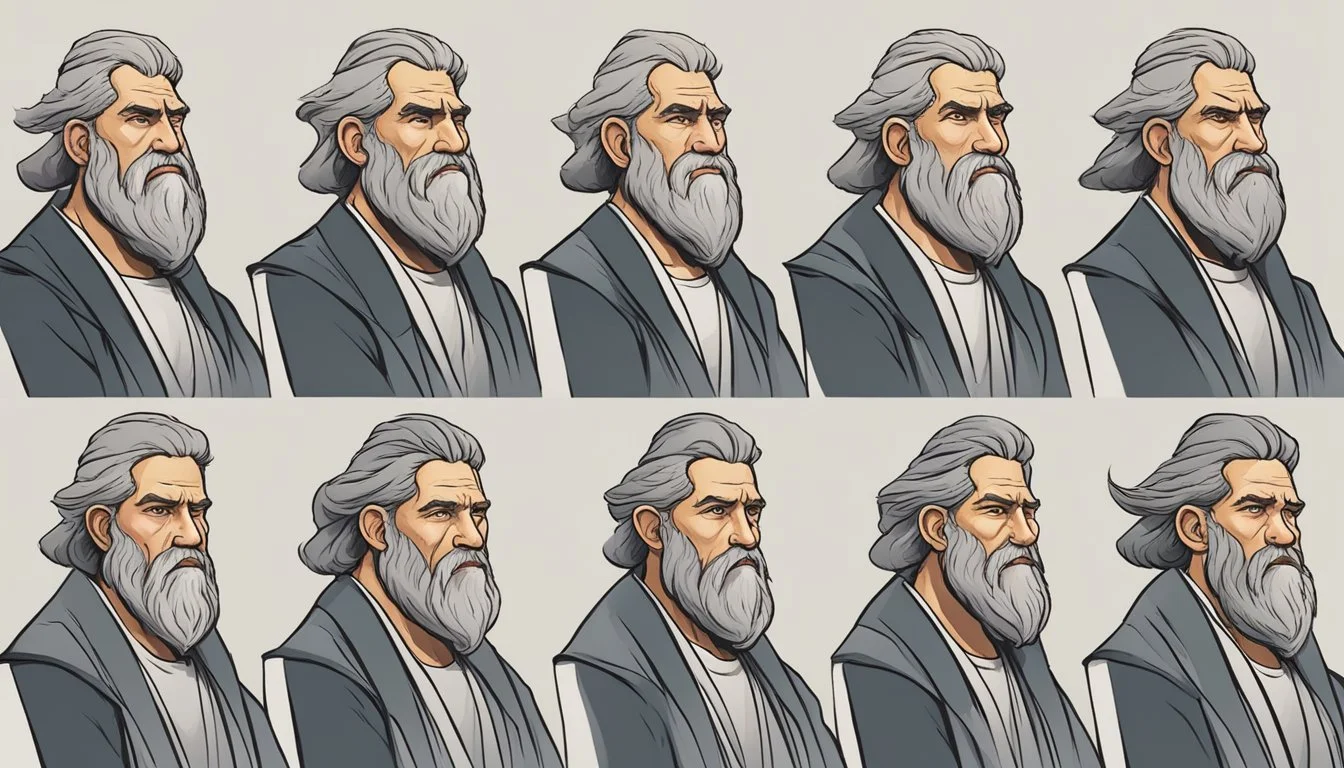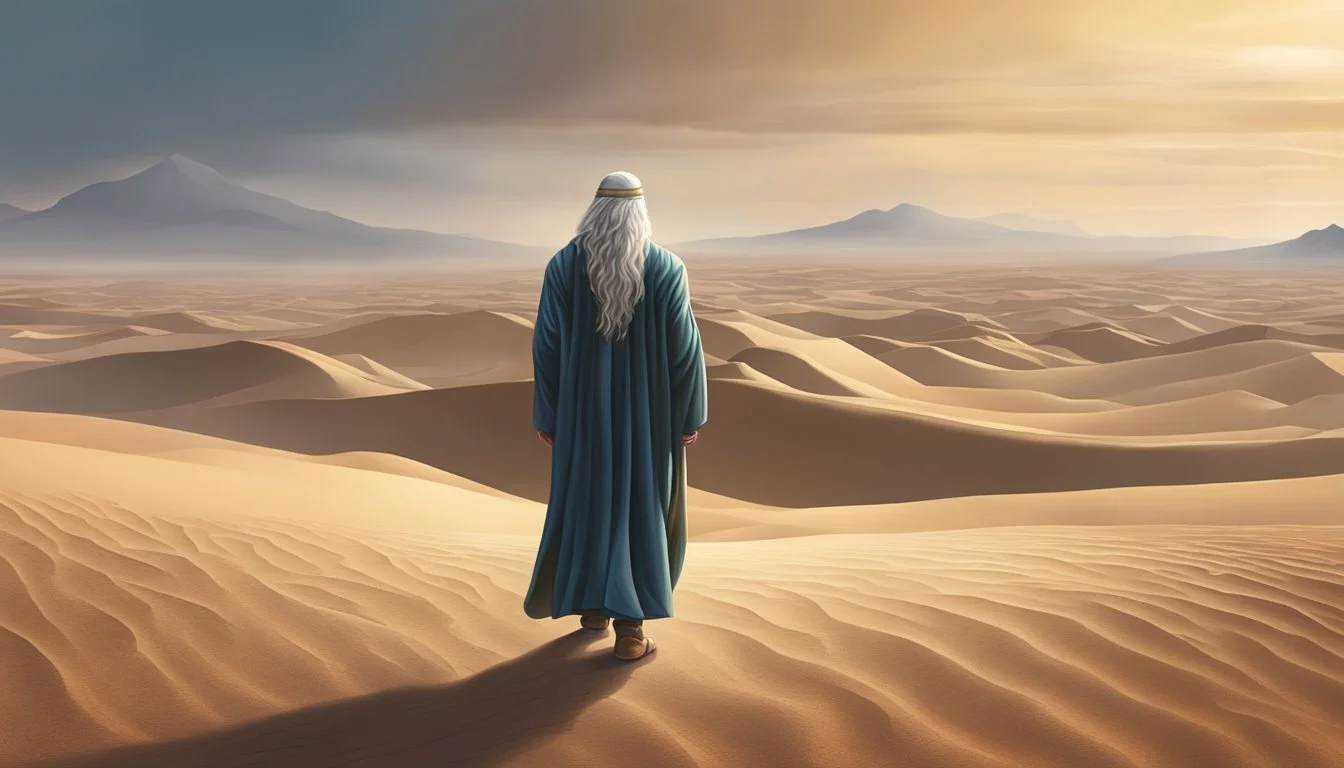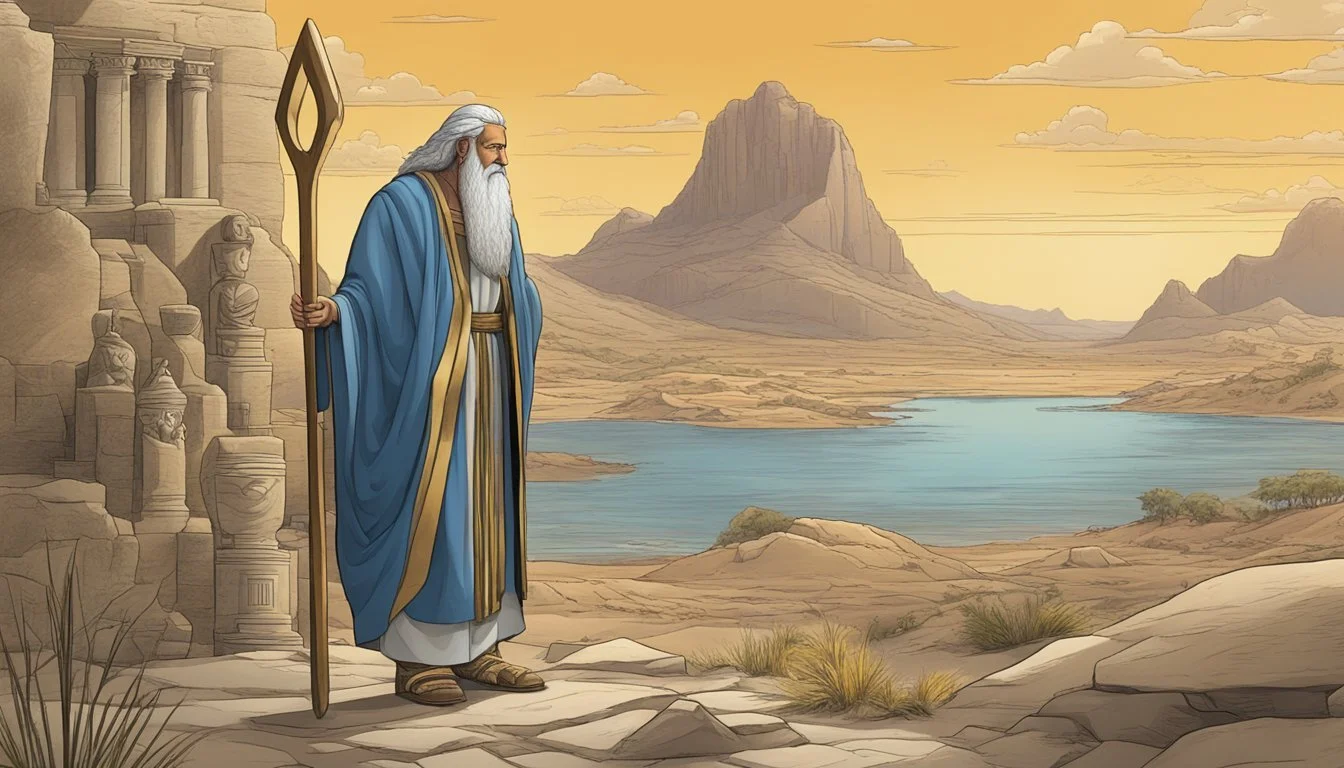The Evolution of Moses' Character Throughout the Series
From Reluctant Leader to Legendary Prophet
Moses, a central figure in the Bible, undergoes a remarkable transformation throughout his journey from Egyptian prince to Hebrew leader. His character evolves from a hesitant fugitive to a confident prophet, shaped by divine encounters and the challenges of guiding the Israelites to freedom.
As Moses faces increasingly difficult trials, he develops unwavering faith, humility, and perseverance. These qualities emerge as he confronts Pharaoh, parts the Red Sea, and leads his people through the wilderness. His growth is evident in his ability to mediate between God and the Israelites, demonstrating patience and wisdom in the face of their frequent complaints and rebellions.
The evolution of Moses' character is marked by his deepening relationship with God. Through repeated interactions on Mount Sinai and in the Tent of Meeting, Moses becomes so attuned to the divine presence that his face begins to shine. This physical manifestation reflects the internal transformation of a man who started as an uncertain shepherd and became one of the most revered prophets in history.
Origins and Early Life of Moses
Moses' early years were marked by extraordinary circumstances that shaped his unique identity and destiny. His journey from an endangered Hebrew infant to an Egyptian prince set the stage for his pivotal role in history.
Birth and Adoption by Pharaoh's Daughter
Moses was born to Hebrew parents during a time of oppression in Egypt. Pharaoh had ordered the killing of all Hebrew male infants. To save her son, Moses' mother placed him in a basket on the Nile River.
Pharaoh's daughter discovered the infant while bathing. Moved with compassion, she decided to adopt him. In a twist of fate, Moses' own mother was hired as his nursemaid.
The name "Moses" was given by Pharaoh's daughter, meaning "drawn out" of the water.
Moses' Egyptian Royalty and Hebrew Roots
As a prince of Egypt, Moses received the finest education and training. He grew up in luxury, learning the ways of the royal court.
Despite his privileged upbringing, Moses maintained a connection to his Hebrew heritage. This dual identity created internal conflict as he witnessed the suffering of his people.
Moses' unique position bridged two worlds - the oppressors and the oppressed. This perspective would later prove crucial in his role as liberator.
Encounter with Injustice and Exodus to Midian
At age 40, Moses witnessed an Egyptian beating a Hebrew slave. Enraged, he killed the Egyptian and hid the body.
When word of his actions spread, Moses feared for his life and fled Egypt. He sought refuge in Midian, a land east of Egypt.
In Midian, Moses encountered a group of shepherdesses being harassed at a well. He intervened, helping them water their flocks.
This act of kindness led to Moses marrying Zipporah, daughter of a Midianite priest. He settled into a new life as a shepherd, far from the splendor of Egypt's palaces.
Call to Leadership
Moses' transformation from shepherd to leader of Israel began with a divine encounter and culminated in a confrontation with Pharaoh. This pivotal period marked the start of Moses' journey as prophet and liberator of his people.
The Burning Bush Revelation
At Mount Horeb, Moses encountered God in the form of a burning bush. This miraculous event changed the course of his life. God called Moses to lead the Israelites out of slavery in Egypt. Initially hesitant, Moses voiced his doubts about his ability to fulfill this role.
God reassured Moses, promising divine support and granting him miraculous signs to perform. These included turning his staff into a snake and making his hand temporarily leprous. Despite his lingering reservations, Moses ultimately accepted the call to leadership, demonstrating a growing trust in God's plan.
Return to Egypt and Encounter with Pharaoh
Moses returned to Egypt, reuniting with his brother Aaron. Together, they approached Pharaoh to demand the release of the Israelites. Pharaoh refused, leading to a series of confrontations and the famous plagues of Egypt.
Throughout these encounters, Moses' leadership skills were put to the test. He faced Pharaoh's hostility and the increasing hardships of the Israelites. Moses learned to balance diplomacy with divine authority, relying on God's guidance to navigate complex political situations.
His persistence and faith in the face of repeated setbacks showcased his growing strength as a leader. This period solidified Moses' role as both prophet and advocate for his people, setting the stage for the Exodus.
Liberation of the Israelites
Moses led the Israelites out of Egypt in a dramatic series of events that demonstrated divine power and protection. This pivotal moment in history shaped the Israelite identity and established their faith in God's deliverance.
Plagues upon Egypt and the Exodus
God sent ten plagues to convince Pharaoh to release the Israelites. These plagues included water turning to blood, frogs, lice, flies, livestock disease, boils, hail, locusts, darkness, and the death of firstborn sons. Each plague targeted an Egyptian deity, challenging their power.
The final plague, the death of firstborns, prompted Pharaoh to let the Israelites go. Moses instructed the people to mark their doorposts with lamb's blood, ensuring their protection. This event became the basis for the Passover celebration.
As the Israelites left Egypt, they took with them gold, silver, and clothing given by the Egyptians. This exodus marked the end of their slavery and the beginning of their journey to freedom.
Crossing the Red Sea and Miracles in the Desert
Pharaoh changed his mind and pursued the Israelites with his army. Trapped between the Egyptian forces and the Red Sea, Moses stretched out his staff. God parted the waters, allowing the Israelites to cross on dry land. When the Egyptians followed, the sea closed over them.
In the desert, God provided miraculous sustenance. Manna appeared each morning for food, and water flowed from a rock when Moses struck it with his staff. These miracles strengthened the Israelites' faith and reliance on divine protection.
During their journey, the Israelites faced challenges that tested their trust in God. Moses' leadership and faith played a crucial role in guiding them through these trials, reinforcing their identity as God's chosen people.
Covenant at Mount Sinai
The covenant at Mount Sinai marked a pivotal moment in Moses' leadership and the formation of Israelite identity. God established His covenant with the people through Moses, providing divine laws and guidance.
Receiving the Ten Commandments
Moses ascended Mount Sinai to receive God's commandments. The Ten Commandments formed the core of the covenant, outlining fundamental moral and religious principles. These laws covered worship, social relationships, and ethical behavior.
God inscribed the commandments on stone tablets, symbolizing their permanence and divine origin. Moses acted as mediator between God and the Israelites, relaying the laws and expectations.
The covenant established at Sinai became the foundation of Israelite religious and civil law. It defined their relationship with God and set them apart as a chosen people.
The Golden Calf Incident
While Moses was on the mountain, the Israelites grew impatient and created a golden calf to worship. This act of idolatry directly violated the covenant they had just agreed to uphold.
Upon descending, Moses witnessed the people's unfaithfulness. In his anger, he shattered the stone tablets containing the commandments. This dramatic action symbolized the broken covenant.
Moses interceded on behalf of the people, pleading with God for mercy. His role as mediator became crucial in preserving the relationship between God and the Israelites.
Constructing the Tabernacle
Following the golden calf incident, God instructed Moses to build a tabernacle. This portable sanctuary would serve as a dwelling place for God's presence among the people.
Moses oversaw the construction, ensuring every detail met God's specifications. The tabernacle included the Ark of the Covenant, which housed the stone tablets of the Ten Commandments.
The completion of the tabernacle symbolized the restoration of the covenant relationship. It provided a tangible reminder of God's presence and the laws given at Mount Sinai.
Wanderings in the Desert
Moses led the Israelites through the wilderness for 40 years, facing numerous challenges and tests of faith. This period shaped his role as a leader, judge, and intermediary between God and the people.
Provision and Testing in the Wilderness
The Israelites' journey through the desert was marked by divine provision and trials. God supplied manna from heaven and water from rocks to sustain the people. Moses struck a rock at Meribah to provide water, demonstrating God's power and mercy.
The Israelites faced battles against other nations, testing their reliance on God. Moses raised his staff during conflicts, symbolizing divine intervention. These experiences strengthened the people's faith and Moses' leadership.
Challenges arose as the Israelites complained about food and water shortages. Moses interceded on their behalf, showcasing his role as mediator between God and the people.
Moses as Judge and Leader
Throughout the desert wanderings, Moses' leadership skills were put to the test. He settled disputes among the Israelites, establishing a system of judges to help manage the growing nation.
Moses received the Ten Commandments and other laws on Mount Sinai, solidifying his role as lawgiver. He communicated God's instructions to the people, shaping their religious and social practices.
The bronze serpent incident highlighted Moses' ability to guide the Israelites through spiritual crises. When poisonous snakes plagued the camp, Moses erected a bronze serpent as a symbol of healing and faith.
Moses faced rebellion from within his own ranks, including challenges from his siblings. These trials refined his character and reinforced his authority as God's chosen leader.
Moses' Legacy and Death
Moses' final days were marked by profound moments that solidified his enduring legacy. His leadership, faith, and impact on the Israelites shaped their identity for generations to come.
Final Speeches and the View of the Promised Land
In Deuteronomy, Moses delivered his farewell addresses to the Israelites. He recounted their journey, reminded them of God's laws, and urged them to remain faithful. These speeches served as a final testament to his leadership and wisdom.
God allowed Moses to view the Promised Land from Mount Nebo in Moab. Although he couldn't enter, this moment symbolized the fulfillment of God's promise to His people.
Moses' final act of leadership was blessing the tribes of Israel, emphasizing their unique roles in the future of the nation.
Succession by Joshua and Moses' Death
Moses appointed Joshua as his successor, ensuring continuity in leadership for the Israelites. He publicly commissioned Joshua, charging him with the responsibility of guiding the people into the Promised Land.
According to the Biblical narrative, Moses died in Moab at the age of 120. The Old Testament states that God Himself buried Moses, and no one knows the exact location of his grave.
Moses' death marked the end of an era, but his influence persisted. His role as lawgiver, prophet, and leader left an indelible mark on Israelite history and religious thought.
Moses' Impact on Judeo-Christian Tradition
Moses profoundly shaped Judeo-Christian beliefs and practices through his role as lawgiver and prophet. His interactions with God and leadership of the Israelites established fundamental religious and ethical principles.
Theologians' Perspectives on Moses
Christian theologians like Paul Tillich and Reinhold Niebuhr emphasized Moses' significance in developing monotheism. They viewed him as a pivotal figure in establishing ethical monotheism and laying the groundwork for later religious thought.
Jewish scholars highlight Moses' role in receiving and transmitting divine law. His experiences on Mount Sinai and delivery of the Ten Commandments are seen as foundational moments in Judaism.
Both traditions revere Moses as an exemplar of faith and obedience to God. His willingness to confront Pharaoh and lead the Exodus demonstrates courage in the face of adversity.
Moses in Jewish and Christian Texts
The Torah presents Moses as the greatest prophet in Jewish history. It details his life from birth through the Exodus and wilderness wanderings. Moses' direct communication with God and role in establishing religious laws are central themes.
Christian scriptures portray Moses as a precursor to Jesus. The Gospel of Matthew draws parallels between their lives, including threats in infancy and time spent in the wilderness.
Both faiths view Moses as a model of leadership and devotion to God. His actions in freeing the Israelites from slavery and guiding them to the Promised Land inspire believers. The enduring impact of the Ten Commandments and other Mosaic laws on Western moral and legal codes demonstrates his lasting influence.
Cultural and Historical Significance
Moses remains a pivotal figure in religious and cultural traditions worldwide. His story continues to inspire artistic interpretations and philosophical discussions about leadership, morality, and faith.
Moses in Art and Literature
Countless artworks depict key moments from Moses' life. Michelangelo's statue in Rome and his Sistine Chapel frescoes are among the most famous representations. Paintings by Rembrandt and Poussin also capture dramatic scenes from the Exodus narrative.
In literature, Moses features prominently in works spanning centuries. John Milton's "Paradise Lost" references him, while Zora Neale Hurston's "Moses, Man of the Mountain" reinterprets his story through an African American lens.
Modern films and TV series continue to explore Moses' character, often portraying him as a complex, conflicted leader grappling with his extraordinary fate.
Contemporary Relevance and Symbolism
Moses remains a powerful symbol of liberation and moral leadership. His story resonates in civil rights movements and social justice campaigns worldwide.
The Ten Commandments, attributed to Moses, still influence legal and ethical frameworks in many societies. Debates about their public display highlight ongoing tensions between religious tradition and secular governance.
Moses' struggle with his identity as both Hebrew and Egyptian royal speaks to modern issues of cultural assimilation and dual heritage. His role as lawgiver and prophet continues to shape discussions about the relationship between divine authority and human governance.







